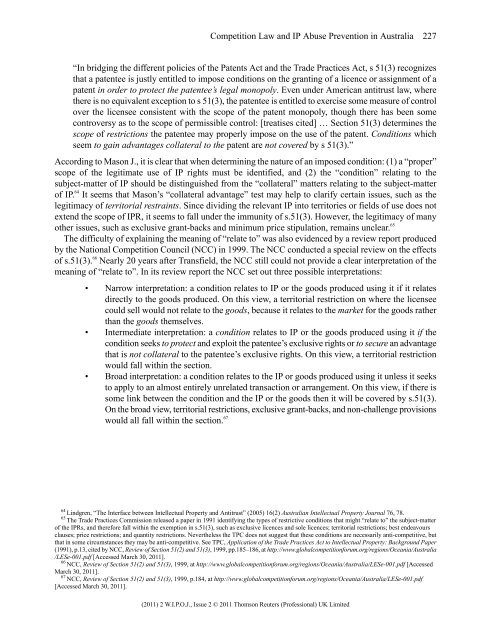WIPO Journal - World Intellectual Property Organization
WIPO Journal - World Intellectual Property Organization
WIPO Journal - World Intellectual Property Organization
You also want an ePaper? Increase the reach of your titles
YUMPU automatically turns print PDFs into web optimized ePapers that Google loves.
“In bridging the different policies of the Patents Act and the Trade Practices Act, s 51(3) recognizes<br />
that a patentee is justly entitled to impose conditions on the granting of a licence or assignment of a<br />
patent in order to protect the patentee’s legal monopoly. Even under American antitrust law, where<br />
there is no equivalent exception to s 51(3), the patentee is entitled to exercise some measure of control<br />
over the licensee consistent with the scope of the patent monopoly, though there has been some<br />
controversy as to the scope of permissible control: [treatises cited] … Section 51(3) determines the<br />
scope of restrictions the patentee may properly impose on the use of the patent. Conditions which<br />
seem to gain advantages collateral to the patent are not covered by s 51(3).”<br />
According to Mason J., it is clear that when determining the nature of an imposed condition: (1) a “proper”<br />
scope of the legitimate use of IP rights must be identified, and (2) the “condition” relating to the<br />
subject-matter of IP should be distinguished from the “collateral” matters relating to the subject-matter<br />
of IP. 64 It seems that Mason’s “collateral advantage” test may help to clarify certain issues, such as the<br />
legitimacy of territorial restraints. Since dividing the relevant IP into territories or fields of use does not<br />
extend the scope of IPR, it seems to fall under the immunity of s.51(3). However, the legitimacy of many<br />
other issues, such as exclusive grant-backs and minimum price stipulation, remains unclear. 65<br />
The difficulty of explaining the meaning of “relate to” was also evidenced by a review report produced<br />
by the National Competition Council (NCC) in 1999. The NCC conducted a special review on the effects<br />
of s.51(3). 66 Nearly 20 years after Transfield, the NCC still could not provide a clear interpretation of the<br />
meaning of “relate to”. In its review report the NCC set out three possible interpretations:<br />
• Narrow interpretation: a condition relates to IP or the goods produced using it if it relates<br />
directly to the goods produced. On this view, a territorial restriction on where the licensee<br />
could sell would not relate to the goods, because it relates to the market for the goods rather<br />
than the goods themselves.<br />
• Intermediate interpretation: a condition relates to IP or the goods produced using it if the<br />
condition seeks to protect and exploit the patentee’s exclusive rights or to secure an advantage<br />
that is not collateral to the patentee’s exclusive rights. On this view, a territorial restriction<br />
would fall within the section.<br />
• Broad interpretation: a condition relates to the IP or goods produced using it unless it seeks<br />
to apply to an almost entirely unrelated transaction or arrangement. On this view, if there is<br />
some link between the condition and the IP or the goods then it will be covered by s.51(3).<br />
On the broad view, territorial restrictions, exclusive grant-backs, and non-challenge provisions<br />
would all fall within the section. 67<br />
64<br />
Lindgren, “The Interface between <strong>Intellectual</strong> <strong>Property</strong> and Antitrust” (2005) 16(2) Australian <strong>Intellectual</strong> <strong>Property</strong> <strong>Journal</strong> 76, 78.<br />
65<br />
The Trade Practices Commission released a paper in 1991 identifying the types of restrictive conditions that might “relate to” the subject-matter<br />
of the IPRs, and therefore fall within the exemption in s.51(3), such as exclusive licences and sole licences; territorial restrictions; best endeavours<br />
clauses; price restrictions; and quantity restrictions. Nevertheless the TPC does not suggest that these conditions are necessarily anti-competitive, but<br />
that in some circumstances they may be anti-competitive. See TPC, Application of the Trade Practices Act to <strong>Intellectual</strong> <strong>Property</strong>: Background Paper<br />
(1991), p.13, cited by NCC, Review of Section 51(2) and 51(3), 1999, pp.185–186, at http://www.globalcompetitionforum.org/regions/Oceania/Australia<br />
/LESe-001.pdf [Accessed March 30, 2011].<br />
66<br />
NCC, Review of Section 51(2) and 51(3), 1999, at http://www.globalcompetitionforum.org/regions/Oceania/Australia/LESe-001.pdf [Accessed<br />
March 30, 2011].<br />
67<br />
NCC, Review of Section 51(2) and 51(3), 1999, p.184, at http://www.globalcompetitionforum.org/regions/Oceania/Australia/LESe-001.pdf<br />
[Accessed March 30, 2011].<br />
Competition Law and IP Abuse Prevention in Australia 227<br />
(2011) 2 W.I.P.O.J., Issue 2 © 2011 Thomson Reuters (Professional) UK Limited

















